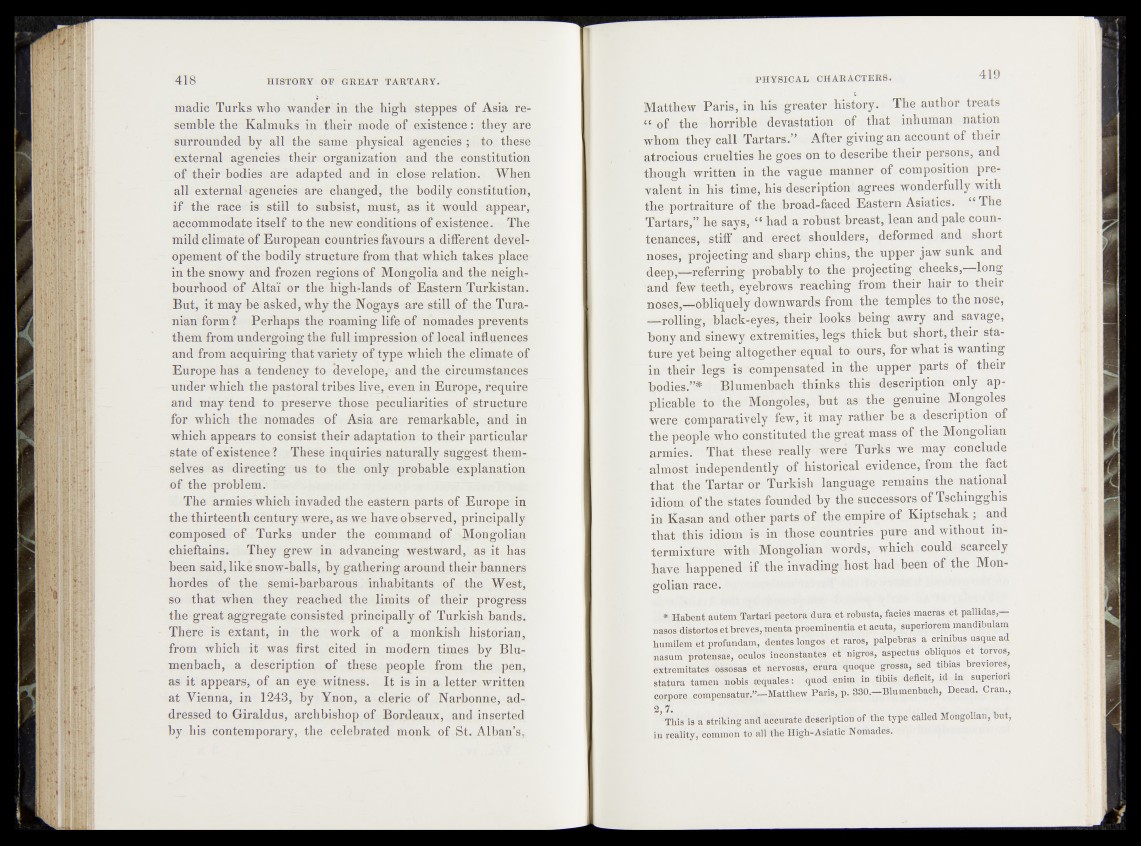
madie Turks who wander in the high steppes of Asia resemble
the Kalmuks in their mode of existence: they are
surrounded by all the same - physical agencies ; to these
external agencies their organization and the constitution
of their bodies aré adapted and in close relation. When
all external*agencies are changed, the bodily constitution,
if the race is still to subsist, must, as it would appear,
accommodate itself to the new conditions of existence;: The
mild climate of European countries favours a different devel-
opement of the bodily structure from that which takes place
in the snowy and frozen regions of Mongolia and the neighbourhood
of Altai" or the high-lands of Eastern Turkistan.
But, it may be asked , why the Nogays are still of the Turanian
form? Perhaps the roaming life of no mades prevents
them from undergoing the full impression of local influences
and from acquiring that variety of type which the climate of
Europe has a tendency to tlevelope/4 and the circumstances
under which the pastoral tribes live, even in Europe, require
and may tend to preserve those peculiarities, of structure
for which the nomades of Asia are remarkable, an
which appears to consist their adaptation to their particular
state of existence ? These inquiries naturally suggest themselves
as directing Us to the only. probable explanation,
of the problem.
The armies which invaded the eastern parts of Europe in
the thirteenth century were, as we have observed, principally
composed of Turks under the command of; Mongolian
chieftains. They grew in advancing westward, as it has
been said, liké snow-balls, by gathering around their banners
hordes of the semi-barbarous inhabitants of the West,
so. that when they reached the limits of their progress
the great aggregate consisted principally of Turkish bands.
There is extant, in the work of a monkish historian,
from which it was first cited in modern times by Blumen
bach, a description of these people from the pen,
as it appears, of an eye witness. It is in a letter written
at Vienna, in 1243, by Ynon, a cleric of Narbonne, addressed
'to Giraldus, archbishop of Bordeaux, and inserted
by his contemporary, the. celebrated monk of St. Alban’s,
Matthew Pams, in his' greater history. The author treats
‘feiof the ^horrible devastation of that inhuman nation
whom they call Tartars.” After giving an account of their
atrocious cruelties he goes on to describe their persons, and
though writtenjjdto the vague manner decomposition prevalent
in* his time,,his description agrees wonderfully with
the portraiture of the broad-faced Eastern Asiatics. “ The
Tartars,” he says, “ had a röbuat breastvlean and pale countenances,
stiff and erect- shoulders, deformed and short
noses, projecting and sharp chins.*, the upper jaw sunk and
deep,—referring probably to the projecting cheeks,- long
*ahd few teeth, eyebrows reaching from their hair to heir
noses,—obliquely downwards from the temples to -the nose,
^rolling, black-eyes, their look&ibeing, awry and savage,
bony and sinewy extremities^lfegs thick?but- short, their .stature,
yqt’being altogether equal to ours, for what is wanting
in their legs is compensated in the upper parts of their
bodies.”* Blumenbach thinksr.-tKis description only applicable.;
to ; the Mongoles,I but as the genuine Mongoles
were comparatively few, it maysrathembe-a description of
the people who constituted thagreat mass of the Mongolian
armies. That these' really were Turks we mayt:conclude
almost ^independently of historical evidence,'from the fact
that the Tartar or Turkish language remains the national
idiom of the states founded by the successors of Tschingghis
in Kasan and other parts of the empire of Kiptschak ; and
that Äsi idiom is in those countries pure and without intermixture
with Mongolian words, which could scarcely
have happened if the invading host had been of the Mongolian
race.
* Habent autem Tartari pectora dura et robusta, facies macras et pallidas,
nasos distortos et breves, men ta proemineutiaet acuta, supaçiorem map<I|*ilam
humilem et profundam, deute sïw ffo sji jaros, paîpebras a crhdbys usque ad
nàsùm protensas, ocdlos inconstantes' éPSig^s, aspe'ctds obhquos -fet torvos,
extremitates ossosas et nervosâs, crura qûoqüè gfossa, sed tibias breviores,
statura tamen nobis æquales: quod enim in Hbiis deficit, id; in, supenori
corpora compensatur.”-Matthcw Paris#p. 330.-Blumenbach, Decad. Cran.,
2 7.
i This is à strikingstod accurate descriptiolTof the type called Mongolian, but,
in reality, common to all the High-Asiatic Nomades.